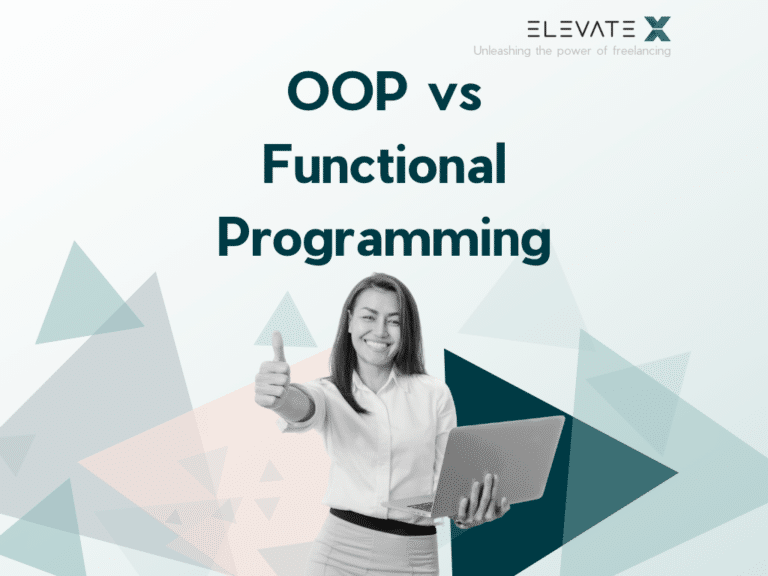Software development processes provide programs. This involves starting from real-world scenarios that need to be translated into a programming language. These scenarios can involve calculations, computer games, customer data management, or table content.
In this article, you will receive information about the advantages and disadvantages of functional (FP) and object-oriented programming (OOP). In this context, the following questions will also be answered: When is each type of programming applied? Is there a clear favorite, or does each type of programming cover a well-defined area in which it is unrivaled?
What Is Functional Programming?
Functional programming has been known since 1930 and is predominantly used in technical and mathematical fields. The reason for this lies in the variety of options for algebraic program synthesis and program transformation. Additionally, it avoids side effects, and there is no need to consider the internal states of the calculation process.
Functional programming is based on the principle of functions. Each function is a specialized and reusable unit that, when combined, leads to a program that provides solutions to complex tasks, such as calculations or processes. Functions form a hierarchical structure through their composition, enabling the solution of complex tasks.
Programs are formulated at a mathematical level, meaning they do not depend on the structure and state of a machine, making them timeless.
KEY POINTS
- Software development translates the real world into programs.
- Functional and object-oriented programming pursue the same goal in different ways.
- There is no universal programming language; the choice depends on requirements.
- A combination of FP and OOP is possible, depending on the programming language and application.
What Is Object-Oriented Programming (OOP)?
In OOP, defined methods or classes can be used across objects. It is based on data and objects, as opposed to functional programming, which is based on functions and logic. Here, objects are treated as data fields with unique attributes and behaviors.
OOP includes the following principles:
- Encapsulation: All information is contained within the object, and other objects do not have access to this class. This ensures a high level of program security and greatly reduces the risk of data falsification.
- Abstraction: Unnecessary implementation details are hidden from other objects. However, a derived class can be extended to make changes.
- Inheritance: Object-oriented programming allows classes to reuse code from other classes. This approach ensures accuracy and shorter development time since common logic can be reused while maintaining a hierarchy.
- Polymorphism: This reduces the need to duplicate code. The program determines which use is required from a parent class for the object. The functionality of a so-called parent class is extended to a child class.
Popular pure OOP languages include Ruby, JADE, Scala, and Emerald.
Advantages Of OOP
- Encapsulation facilitates debugging.
- Time savings through inheritance, as the same code can be reused without rewriting.
- Abstraction and encapsulation enhance security, make software maintenance easier, and protect internet protocols.
- Programs can be easily extended because system functionalities can be implemented independently.
- Code streamlining reduces repetitions that lead to program errors.

Functional Programming VS. OOP: Pros And Cons
The evolution of programming also brings about trends. Therefore, countless web developments and computer games now rely on object-oriented programming. This paradigm describes elements not as functions but as objects. The advantage of this approach is the ability to reuse all components and make extensions.
The advantage of functional programming is that the functional code appears much more straightforward, which is important in areas where verifiable and testable code is needed.
Not sure which one to choose? It’s often not necessary to choose between functional or object-oriented programming. Many programming languages now support both paradigms. Therefore, you can benefit from the advantages of both paradigms by combining them where possible. For example, Scala, F#, and JavaScript support both object-oriented programming and functional programming patterns.
Programming Paradigms
In general terms, a paradigm refers to a specific view or approach. When it comes to programming, the term paradigm refers to the fundamental style and principles used in developing a program.
Programming paradigms are divided into two main groups: imperative and declarative programming.
- Imperative Programming: The software follows instructions in a predefined sequence. This paradigm is used in programming languages like Ada and C.
- Declarative Programming: This paradigm reverses the approach of imperative programming. In declarative programming, the focus is on defining the end product, not the solution path. Unlike imperative programming, it is not concerned with how to achieve the result. Suitable programming languages for this paradigm include Haskell and LISP.
Subordinate Paradigms
Both main groups are further divided into subordinate paradigms. For example, procedural and object-oriented programming belong to the imperative programming category, while declarative programming is subdivided into functional and logical programming.
Most programming languages can work with multiple paradigms simultaneously. Therefore, you don’t necessarily have to commit to a single programming paradigm. Your preferences and the specific task at hand determine the choice of the appropriate paradigm.
Are you looking for software developers?
Objects and Classes
Objects
Objects that appear on the screen can be compared to real-life objects, such as houses, trees, or furniture. These objects can be composed of other objects, like a cabinet made up of doors, compartments, drawers, and mirrored fronts. An object arises from a logically related set of data that is created based on a specific “blueprint.” This means that a concrete object is derived from or can be divided into classes. Colors, shapes, or behavioral patterns come into play, giving objects characteristic features.
Classes
Classes are fundamental building blocks within object-oriented programming. They ensure so-called reusability, allowing code to be written only once. The concept can be likened in the real world to using a pattern template made of paper. The pattern template represents the object that can be modified. For a specific model (dress, pants, jacket), the components are depicted in various sizes, offering fabric alternatives and different sewing instructions based on the material chosen. Reusing a pattern template saves time and material. This can also be applied to programming, as classes can be created with a single code that can be reused repeatedly.
In other words, classes in object-oriented programming serve as templates for creating objects based on the same pattern. They function like a blueprint that includes object functionalities.
Mutable And Immutable Objects And Classes
Most software errors can be traced back to incorrect values being input. For instance, calculations may only occur after a check, or faulty values may not be reevaluated. Therefore, mutability is the norm in programming languages, while immutability is the exception.
Mutable objects can be edited after their creation, allowing variables’ values to be changed without needing to rewrite the entire object. If you need to change an immutable object, it can only be done through reprogramming the object.
Conclusion
Functional programming languages are currently less popular. This may be due to the high level of mathematics on which functional programming languages are based. In contrast, Java and C++ represent popular object-oriented programming languages. Just like in everyday life, there is no one-size-fits-all solution for every situation. Increasing specialization means more possibilities are available. Therefore, the choice of which paradigm to use should be made separately for each project.
- Functional programming (FP) is mainly used in technical and mathematical fields.
- Object-oriented programming (OOP) is used for processing data and objects in software.
There is no clear favorite. Both paradigms have their advantages and disadvantages, and the choice depends on the specific requirements of the project.
Yes, many programming languages support both object-oriented and functional programming patterns, allowing you to leverage the benefits of both paradigms where it makes sense. Some examples of such languages are Scala, F#, and JavaScript.








